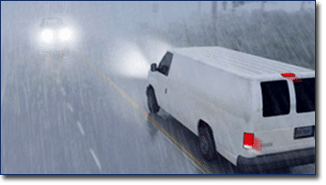




Driving Hazard Recognition
With our Driving Hazard Recognition course, employees will learn techniques for negotiating intersections and blind spots as well as avoiding erratic drivers, pedestrians, animals, and parked vehicles. They will also learn about driving with limited visibility and in slippery conditions. Paying extra attention to common driving hazards can help ensure that your passengers and cargo return home safely.
Request a demoCourse Details
Learning Objectives
- Identify common driving hazards at intersections
- Recognize and avoid blind spots
- Drive safely with limited visibility
- Maintain control in slippery conditions
- Handle encounters with erratic drivers
- Navigate safely around pedestrians, animals, and parked vehicles
Specs
| Course Level | Intermediate |
| Languages | English |
| Compatibility | Audio, Video |
Key Questions
Common driving hazards include intersections, blind spots, limited visibility, slippery conditions, erratic drivers, pedestrians, animals, and parked vehicles.
Why is distracted driving hazardous?Distracted driving is hazardous because it reduces the driver’s ability to recognize and respond to driving hazards, increasing the risk of accidents.
What are typical rural driving hazards?Typical rural driving hazards include wildlife, narrow roads, sharp curves, and limited visibility due to terrain and weather conditions.
What is the most frequently encountered weather-related driving hazard and how can drivers manage it?The most frequently encountered weather-related driving hazard is rain. Rain reduces visibility and increases the risk of hydroplaning. Drivers should slow down, increase following distances, and ensure tires have good tread. Using headlights in rain also improves visibility. Recognizing and managing these driving hazards is essential for safe driving in wet conditions.
What are the benefits of effective driving hazard recognition training?Effective driving hazard recognition training offers benefits, including improved ability to anticipate and respond to driving hazards, reduced risk of accidents, and enhanced overall road safety. Drivers learn to identify and manage potential risks such as distracted driving, adverse weather conditions, and rural driving hazards. By mastering these skills, drivers can make informed decisions, protect themselves and others on the road, and contribute to a safer driving environment.
Sample Video Transcript
Blind spots are areas of the road that a driver can’t see while looking forward or looking in the rear-view or side-view mirrors. The most common blind spots are areas near the back of the vehicle on both the left and right side, and low spots immediately in front of and behind a vehicle. Larger vehicles, such as those often used in work settings, tend to have larger blind spots and therefore drivers of these vehicles need to be even more careful. Driving Hazard Recognition Page 4 of 5 © Vector Solutions. All rights reserved. Always adjust your mirrors to reduce your blind spots as much as possible, but never trust your mirrors 100 percent. Before you change lanes, put on your blinker and always turn your head and check in the direction you want to turn to make sure there is no vehicle in your blind spot to the side. Likewise, to reduce the chance that another vehicle will accidentally turn into you, minimize the time spent in other vehicle’s blind spots.
Additional Resources
- OSHA Motor Vehicle Safety – https://www.osha.gov/motor-vehicle-safety
- OSHA Workplace Vehicle Safety – https://www.osha.gov/motor-vehicle-safety/safety
- OSHA Safe Driving Practices for Employees Handbook – https://www.osha.gov/sites/default/files/publications/Safe_Driving_Practices.pdf
- FMCSA Work Zone Safety Tips – https://www.fmcsa.dot.gov/ourroads/work-zones-safety-tips
- FMCSA General Safe Driving Resources – https://www.fmcsa.dot.gov/ourroads/general-safe-driving-resources
Course Applies To
Learn more about our courses, get pricing, and see our platform.











